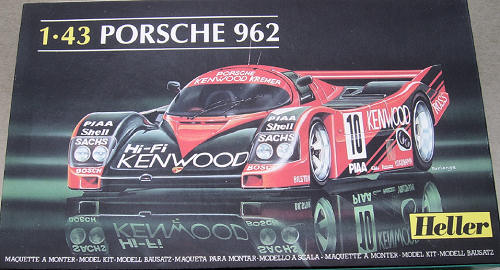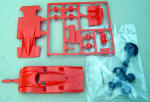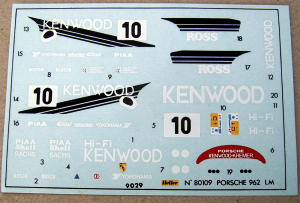
Heller 1/43 Porsche 962, Red and Black Kenwood #10
| KIT: | Heller 1/43 Porsche 962, Red and Black Kenwood #10 |
| KIT #: | 80109 |
| PRICE: | AUD $10.95 in the mid-1990s |
| DECALS: | One option |
| REVIEWER: | Graham Mison |
| NOTES: | CPrevious kit modified with metal axles and vinyl tires |

| HISTORY |
The
Porsche Motor sport division developed the 962 from the very successful 956
mainly to meet the crashworthiness standards of IMSA (International Motor Sports
Association) with the new models first outing in 1984. The new 962 incorporated
a revised front end with the wheelbase extended 12 cms to move the front axle
line to in front of the drivers foot well to meet the IMSA safety rules, overall
length remained the same. Main external difference centre around the area
forward of the doors. The 956/962 combination had an extremely long and
successful competition life with the first 956 hitting the track in 1982 and the
962 in late 1984. 956's won the Le Mans 24 hour event 4 years in a row from
their debut in '82 to '85. 27 956s were produced by the factory
962s
won the French classic in '86, '87 and 1994 and many of the Motor sport worlds
other endurance races and series of that time. Over its racing life the type was
refined and developed by the factory and private racing teams with different
engines, panels, wings and turbos etc. Of the over 148 cars produced, over 50
were built in workshops other than Porsche's. A number of private companies also
produced road versions in the early 1990s.
| THE KIT |
 Heller's
kit of the 962 was originally released in early 1988. Two boxing were marketed,
kit 80187 included decals for the blue Kenwood sponsored #11 and kit 80188 with
decals for the Danone sponsored #33 car. In the 1990s Heller modified the molds
to replace the injection molded tyres and stub axles with vinyl tyres and metal
axles, this brought it into line with the other
Heller's
kit of the 962 was originally released in early 1988. Two boxing were marketed,
kit 80187 included decals for the blue Kenwood sponsored #11 and kit 80188 with
decals for the Danone sponsored #33 car. In the 1990s Heller modified the molds
to replace the injection molded tyres and stub axles with vinyl tyres and metal
axles, this brought it into line with the other
Parts
are loose in the tray style box, with the instruction sheet sandwiched between
the main sprue and the body. This boxing has the clear parts in a plastic bag
with the new tyres and axles.
The total parts count is now 23, 14 in red
with 3 clear, 4 vinyl and 2 metal. Parts breakdown sees a cockpit tub complete
with front faces of the side mounted radiators and the 2 racing seats (the
drivers seat is a separate part) attached to a single piece chassis. The axles
are inserted through this and new style wheels and tyres added. The underside of
the chassis has some molded detail but there is no front suspension and the rear
units are integral with the chassis and look very crude.
The
one-piece body has mostly engraved detail for the doors and other panels, ducts
and side exhaust etc. A separate rear wing is to be mounted onto a couple of
rather thick and inaccurate stubs. Other remaining parts cover the radiator
exits, steering wheel, mirrors, clear headlight covers and the windshield/side
windows. The windshield has a single wiper arm/blade integrally molded and will
be very difficult to paint.
Once again I found only a hint of flash
and that was on the chassis and only a couple of sink marks, which were on the
back of the drivers seat and underneath the cockpit tub. The chassis also has
some mold seams which will need taking care of. Some parts have wide and thick
attachment points to the sprues and the body will need the remnant of its sprue
removed with care
 With
such a low parts count construction will be quite simple with only 2 stages on
the A4 sized instruction sheet. This also includes painting details for
individual parts, Heller paint numbers are used with a conversion chart to
Humbrol paints on a second sheet. In this later release the reverse side of the
instructions sheet shows a 5 view painting and decaling guide with the drawings
in 1/43 scale.
With
such a low parts count construction will be quite simple with only 2 stages on
the A4 sized instruction sheet. This also includes painting details for
individual parts, Heller paint numbers are used with a conversion chart to
Humbrol paints on a second sheet. In this later release the reverse side of the
instructions sheet shows a 5 view painting and decaling guide with the drawings
in 1/43 scale.
The
decals look well printed with close examination showing up some colour
misalignment on the driverís nationality flags.
The
chosen subject is the red and black #10 car out of the Porsche Kremer Racing
workshop driven by
Kunimitsu Takahashi, Giovanni Lavaggi and Bruno Giacomelli from the 1989
An image of this car was found on the web and some differences are noticeable between it and the supplied parts and decals. The biggest is the wheels, it seems that #10 ran in 1989 with the wheel types supplied in the original Heller kits. The majority of Heller decal placement guide is correct, however it seems the drivers names should be located under the rear edge of the windshield.
| CONCLUSIONS |
This
is one kit I would like to see Heller reissue again.
| REFERENCES |
www.racingsportscars.com/photo.html -
Images from many Sports Car races
including the 1989
http://en.wikipedia.org/wiki/Porsche_962
- Information on the 962.
If you would like your product reviewed fairly and quickly, please contact me or see other details in the Note to Contributors.